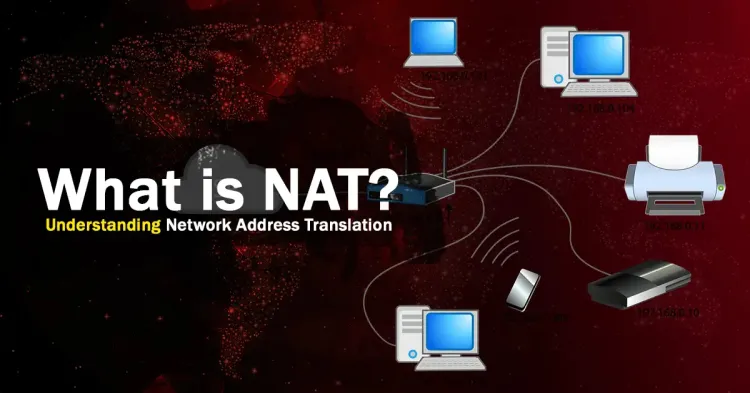What Is NAT? Understanding Network Address Translation
Learn about Network Address Translation (NAT) and how it enables multiple devices on a local network to share a single public IP address. This comprehensive guide covers the types of NAT, how NAT works, and its importance in modern networking. Perfect for networking professionals and enthusiasts looking to deepen their understanding of NAT.

In the interconnected world of networking, the ability to manage and streamline data transmission between different devices is crucial. Network Address Translation (NAT) is a fundamental technology that plays a vital role in this process. Whether you're a networking professional or simply curious about how data travels across the internet, understanding NAT is essential. This article delves into what NAT is, how it works, and why it's so important in today's digital landscape.
What is NAT?
Network Address Translation (NAT) is a method used in networking to modify the IP address information in the header of packets as they pass through a router or firewall. This technology enables multiple devices on a local network to share a single public IP address, effectively conserving the limited number of available IPv4 addresses. NAT is often used in scenarios where internal networks need to communicate with external networks, such as the internet, while hiding the internal IP addresses from external observers.
How Does NAT Work?
NAT operates by translating private IP addresses used within a local network into a public IP address that can be routed on the internet. When a device within a local network sends a request to an external network, the NAT-enabled router changes the private IP address in the packet's header to a public IP address. The router then keeps track of this translation in a NAT table, allowing it to reverse the process when the response from the external network is received. This ensures that the data is sent back to the correct device within the local network.
Types of NAT
There are several types of NAT, each serving a specific purpose:
Static NAT: This type of NAT maps a single private IP address to a single public IP address. It's typically used for devices that need to be accessible from outside the network, such as a web server.
Dynamic NAT: Dynamic NAT maps a private IP address to any available public IP address from a pool. This method is used when multiple devices within a local network need to access the internet, but not all at the same time.
Port Address Translation (PAT): Also known as NAT overload, PAT allows multiple devices to share a single public IP address by using different ports for each connection. This is the most common type of NAT used in home and small business networks.
Why is NAT Important?
NAT is critical for several reasons. Firstly, it helps to conserve the limited number of available IPv4 addresses by allowing multiple devices to share a single public IP address. Secondly, it provides an additional layer of security by hiding the internal IP addresses of devices within a network from external entities. Lastly, NAT facilitates the seamless communication between devices in private networks and external networks, making it a cornerstone of modern networking.
What Does the NAT Architecture Look Like?
The architecture of Network Address Translation (NAT) is designed to manage the translation of IP addresses and ports between a private internal network and the external public network, typically the internet. Understanding the NAT architecture involves recognizing the key components and how they interact within a network. Here’s an overview:
1. Internal Network (Private Network)
Overview: The internal network consists of devices such as computers, servers, smartphones, and IoT devices that use private IP addresses (e.g., 192.168.x.x, 10.x.x.x, or 172.16.x.x). These IP addresses are not routable on the public internet and are used exclusively within the local network.
Role in NAT: Devices within the internal network initiate outbound traffic that needs to be translated by NAT before reaching the public network.
2. NAT Device (Router or Firewall)
Overview: The NAT device, often a router or firewall, is the central component of NAT architecture. This device sits at the boundary between the internal network and the external network. It is responsible for translating private IP addresses and ports into public IP addresses and ports for outbound traffic and vice versa for inbound traffic.
3. Public Network (External Network)
Overview: The public network, typically the internet, is where translated traffic is sent. Devices on the public network communicate using routable IP addresses assigned by ISPs (Internet Service Providers).
Role in NAT: The public network receives requests from the NAT device with a public IP address. It sends responses back to this address, which are then translated back to the corresponding private IP by the NAT device.
4. NAT Table (Translation Table)
Overview: The NAT table is a dynamic data structure within the NAT device that records mappings between private IP addresses and ports and their corresponding public IP addresses and ports. It ensures that incoming responses from the public network are correctly routed back to the originating device within the private network.
Structure:
Private IP: The internal IP address of the device that initiated the connection.
Private Port: The internal port number used by the device.
Public IP: The external IP address used for communication with the public network.
Public Port: The external port number assigned to the connection by the NAT device.
Limitations of NAT
While Network Address Translation (NAT) is a powerful and widely used networking technology, it does have some limitations and challenges that network administrators need to be aware of:
Limited Support for Certain Protocols
Complicated Troubleshooting
Impact on Performance
Challenges with Peer-to-Peer Applications
Security Implications
Compatibility Issues with IPv6
Breaks End-to-End Connectivity
Port Exhaustion
Conclusion
Network Address Translation is a powerful and essential technology in the world of networking. It not only helps in the efficient use of IP addresses but also enhances network security and enables smooth communication between private and public networks. Understanding NAT is crucial for anyone involved in networking or IT, as it plays a key role in how data is routed across the internet. Whether you're setting up a home network or managing a large enterprise infrastructure, NAT is a technology you'll encounter time and time again.
Frequently Asked Questions
1. What is Network Address Translation (NAT)?
Network Address Translation (NAT) is a networking technique used to modify the source or destination IP addresses in packet headers as they pass through a router or firewall. NAT enables multiple devices on a local network to share a single public IP address when accessing the internet, effectively conserving the number of public IP addresses needed.
2. Why is NAT used?
NAT is primarily used to:
Conserve IP Addresses: By allowing multiple devices to share a single public IP address, NAT helps mitigate the shortage of available IP addresses.
Enhance Security: NAT hides the internal IP addresses of devices within a private network from external networks, reducing the risk of direct attacks.
Facilitate Private Networking: NAT allows private networks to use reserved IP address ranges that are not routable on the public internet.
3. What are the main types of NAT?
The main types of NAT are:
Static NAT: Maps a single private IP address to a single public IP address. This is typically used for devices that need a consistent public IP, such as web servers.
Dynamic NAT: Maps private IP addresses to a pool of public IP addresses. The mapping is not fixed, so any available public IP can be assigned to a private IP address.
Port Address Translation (PAT): Also known as NAT overload, PAT maps multiple private IP addresses to a single public IP address using different port numbers. This is the most common form of NAT and is used in home and small business networks.
4. How does NAT work?
NAT works by altering the IP addresses in packet headers as data travels between a private network and the internet. When a device from the private network sends data to the internet, NAT replaces the private IP address with the public IP address of the NAT device. When a response is received, NAT maps the public IP address and port back to the original private IP address, directing the data to the correct internal device.
5. What are the benefits of NAT?
The benefits of NAT include:
IP Address Conservation: Reduces the need for a large number of public IP addresses.
Improved Security: Conceals internal IP addresses from external networks, adding a layer of protection against direct attacks.
Network Flexibility: Allows the use of private IP address ranges within internal networks while still enabling internet access.
6. What are the limitations of NAT?
NAT has several limitations:
Complexity in Protocols: Some protocols that embed IP addresses in their payloads may not work properly with NAT without additional configuration.
End-to-End Connectivity: NAT can complicate peer-to-peer communications and applications that require direct end-to-end connectivity.
Performance Overhead: NAT introduces additional processing overhead on the router or firewall, potentially impacting performance.
7. What is the difference between Static NAT and Dynamic NAT?
Static NAT: Provides a one-to-one mapping between a private IP address and a public IP address. It is fixed and does not change, making it suitable for devices that need a constant public IP.
Dynamic NAT: Uses a pool of public IP addresses to map private IP addresses. The mapping is not fixed and may vary each time a device accesses the internet, suitable for networks with a limited number of public IPs.
8. What is Port Address Translation (PAT)?
Port Address Translation (PAT), also known as NAT overload, allows multiple devices on a local network to share a single public IP address by differentiating traffic based on port numbers. This method uses a combination of the public IP address and different port numbers to keep track of multiple active connections from different devices.
9. How does NAT affect security?
NAT enhances security by masking the internal IP addresses of devices behind a single public IP address. This makes it more difficult for external attackers to directly target internal devices. However, NAT is not a substitute for other security measures, such as firewalls and intrusion detection systems.
10. Can NAT be used with IPv6?
NAT is less commonly used with IPv6 because the vast address space of IPv6 eliminates the need for address conservation that drives NAT in IPv4. IPv6 was designed to provide a unique address for every device, reducing the reliance on NAT. However, NAT64 and other translation techniques may be used to facilitate communication between IPv4 and IPv6 networks.















![Top 10 Ethical Hackers in the World [2025]](https://www.webasha.com/blog/uploads/images/202408/image_100x75_66c2f983c207b.webp)








